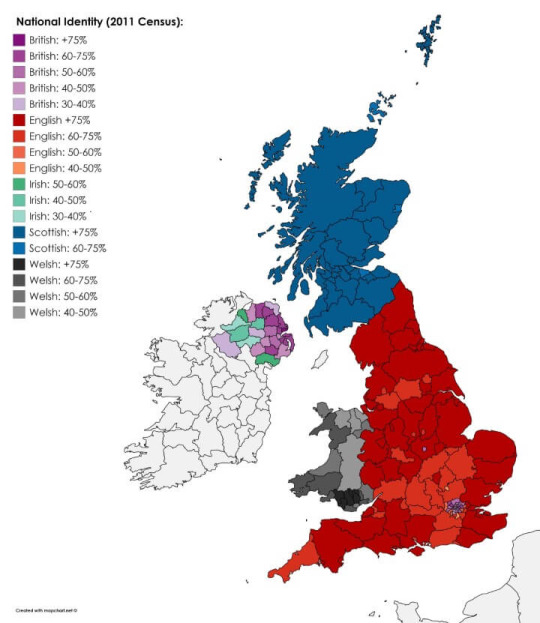#National census
Text
Yknow, I can’t help but wonder why whenever people bring up queerness in ancient times (particularly Roman + Greek,) and some Really Weird Folks have this incessant need to point out “uM ITS NOT THE SAME AS BEING GAY TODAY YOU KNOW, P*****STY WAS THE NORM YOU KNOW,” like why? Why is it that being gay is only accepted when it comes to really gross assault? Why is it only perceivable when it’s something thats distasteful?? Feels like that quiet part ain’t so quiet anymore buddy
#like did Sappho herself give you the deets?#did you personally get Alexander to tell you local faggot census for the entire nation of Macedon in the year 589 BCE???#I’m being sarcastic w/ these dates and numbers btw#the point/message still stands
2 notes
·
View notes
Text
the stranglehold that mormons have on the genealogy field is crazy.
#literally if you look up digitized census records the national archives directs you to ancestry and familysearch!#you have to have a familysearch account...my desire to search census records warring with my desire to not let Big Mormon access my info
12 notes
·
View notes
Text
“If I have often cast a withering glance on post-Stonewall gay identity, and on the politics, literature, music, and sexuality that derive from it, I have done so less out of personal conviction than out of an experimental attitude, one that consists in testing what initially seemed to me to be a counter-intuitive hypothesis: that the Golden Girls might still matter to us a lot more than Edmund White, that Desperate Housewives might prove queerer than Queer as Folk.
But I have also been motivated by the shock and disappointment of seeing a revolutionary movement of sexual liberation and political insurgency settle down into a complacent, essentially conservative form of identity politics that seeks less to change the world than to claim a bigger piece of it. Many gay people nowadays seemed determined to imitate and to reproduce the most trite, regressive social values of heteronormative culture: family, religion, patriotism, normative gender roles—the venerable trinity of Kinder, Küche, Kirche. They have also taken up the heterosexual ethic of erotic impoverishment, which lobbies for the benefits of renouncing sexual pleasure. The less sex you have, so this ethic goes, the more meaningful it will be, and what you should want above all in your sexual life is not pleasure but meaning, meaning at the expense of pleasure, or meaning to the exclusion of pleasure. That is the ethic against which gay liberation once led a world-historical rebellion.
…
My intention has been not to depreciate post-Stonewall gay culture but to champion the forms of social resistance to heteronormativity that much of pre-Stonewall gay culture represented and continues to represent, while exploring the reasons why so many gay men seem to find the official, parochial, rainbow-flag-draped gay identity-based culture that has replaced it so unsatisfying and deficient. I have wanted to discover the source of so much gay discontent.
That discontent is real, and sometimes the political complaint I have just articulated merely serves as an alibi for gay homophobia. Gay men are highly critical, if not contemptuous, of their artists, writers, and filmmakers, just as they are disdainful of their political leaders. That is why gay male cultural production (to say nothing of gay male politics) is such a thankless affair. Gay men may claim they want to see representations of themselves and their lives, but they often don’t like the representations of gay men that gay men produce, or they fail to stay interested in them…
In 1978 the Canadian sociologist, Barry D. Adam…published his doctoral dissertation (which became the first of his many books), called The Survival of Domination: Inferiorization and Everyday Life. A comparative study of Blacks, Jews, lesbians, gay men, concentration camp prisoners, children, and other inmates of ‘total institutions,’ it was an early classic of lesbian/gay/queer studies, and it remains worth reading today. Among the coping mechanisms that Adam found to be common to the various oppressed groups he studied were what he called the ‘flight from identity’ and ‘in-group hostility.’
Those phrases referred to social and individual strategies by which members of oppressed groups sought to lessen the personal cost and psychological pain of social rejection. They tried, for example, to escape the social marking responsible for their inferior status by refusing to identify with the group to which they belonged, by showing dislike or contempt for other members of that group—especially for those individuals more indelibly marked than themselves by the stigmatizing signs that identified them as belonging to it—and by shunning contact with people from their own communities.
Adam’s account of social domination and it’s consequences continues to have a lot of explanatory power. Still, as Adam himself would be the first to admit, and as his subsequent work suggests, the vicissitudes of inferiorization and abjection do not entirely explain or exhaust the meaning of the phenomena I have been trying to explore. The repudiation of contemporary gay culture, and the ongoing popularity of suitably queered items appropriated from mainstream, heterosexual culture, cannot be reduced to a mere symptom of internalized homophobia. Nor does the perennial gay preference for camp readings of heterosexual culture merely reflect a failure to achieve gay pride or the incurable effects of social domination. On the contrary, the strategic appropriation of straight culture continues to serve vital purposes for gay men, and others, and to provide an important, if implicit, vehicle of social critique and political resistance.”
David M. Halperin, How to Be Gay
#fandom problems#but also fandom solutions lol#it’s a lil declinsionist but#that seeking representation especially within the current studio system#is an attempt to use a census-like approach to argue for a bigger claim of an imperial/national power#and ignores aesthetic and political communication as more accurate and liberating reflections of being#also makes me think about how fandom appropriates or interprets a lot of works to reveal or establish queerer and anti colonial themes#anyways
3 notes
·
View notes
Text
these past few days i was pretty chill about the job-y thing i have tomorrow, but now i started to get nervous for real. my main concern tho is coming across as too awkward, which i mean, i know i am, but sometimes i can hide it very well and other times not
and to reiterate, only I, Ms. Social Awkwardness, signs up for the fucking census of all things
#i'm trying to put my energy and thoughts into it going well#expect an update tomorrow of either me being the happiest or my biggest mental breakdown yet#either way i'll be the most awkward census taker this nations has ever seen and i'll be proud of it#now i'm heading off to sleep#hope you guys had a good day! or will have one!#pelotudeces
1 note
·
View note
Note
why are fish glorious? and maybe also your favorite genshin character for the ask game

You don't get creatures like this anywhere in the world. Fish are glorious.

For the character bingo, Yanfei! Girl is living her best life and we love her for that :)
3 notes
·
View notes
Text
congratulations london, you're officially the gayest place in england
#im loving going through the census results and the ones on 16+ lgbtq+ population were published today#genderqueer people make up 0.5% of the population which is actually more than i thought#and this only counts people aged 16+ in 2021 as well#but yeah 5.31% of the population in lambeth (in london) identity as gay/lesbian which is the highest in the country#but norwich has the largest bisexual population with 3.89% of people identifying as bi#brighton has the most overall queer at 0.28%#this is genuinely really interesting#if you wanna look at more of the statistics theyre out on office for national statistics with a data map#bibliophile-bi
3 notes
·
View notes
Text
This is the last in my ongoing series of posts sharing the list of civil & human rights rollbacks during the Trump administration, which was curated by The Leadership Conference on Civil and Human Rights (https://civilrights.org/trump-rollbacks/). Thank you for reading!
THESE CIVIL AND HUMAN RIGHTS ROLLBACKS HAPPENED AFTER JANUARY 6TH!
During this time, Republicans attacked LGBTQ people, Medicaid, the Department of Health & Human Services, the Census, and executed the 11th, 12th, and 13th federal prisoners in more than 17 years after the Trump administration resumed the federal death penalty. Also, on January 18 (my birthday), which was MLK Day, Trump’s 1776 Commission issued a report calling for “patriotic education,” comparing progressivism to fascism and communism, and justifying the nation’s founding on the basis of slavery.
PLEASE SHARE THIS SERIES! It is important people know. This is just the Trump Administration’s civil and human rights rollbacks. Republican policies also hurt the economy and spread lies about the pandemic. There were major changes in the way business is conducted in the Executive Branch. We need to make sure that a totalitarian is never able to take power again. We need to rollback the rollbacks! We worked too long for hundreds of years for this to fall apart now. We have to come together on what unites us if there is anything left.
On January 8, the Department of Education’s Office for Civil Rights released a memorandum misconstruing the U.S. Supreme Court’s decision in Bostock v. Clayton County and its application to Title IX of the Education Amendments of 1972 – refusing to apply Bostock, which prohibits discrimination against LGBTQ people, to federal education law.
On January 8, the Centers for Medicare and Medicaid Services approved a new Medicaid financing system in Tennessee – a 10-year “experiment” – threatening health care for the 1.4 million people in the state’s Medicaid program.
On January 12, the Department of Health and Human Services finalized a rule that allows social service providers that receive government funding to discriminate based on sexual orientation and gender identity.
On January 12, a letter from the Office of the Inspector General at the Department of Commerce outlined whistleblower complaints that Census Bureau Director Dr. Steven Dillingham ordered staff to prioritize the unconstitutional and premature production of a technical report that would include data on documented and undocumented immigrants in the United States – a directive motivated by partisan objectives. Dr. Dillingham resigned six days later following demands from civil rights organizations and members of Congress that he step down.
On January 13, the federal government executed Lisa Montgomery – the eleventh federal execution in more than 17 years after the Trump administration resumed the federal death penalty.
On January 14, the federal government executed Corey Johnson – the twelfth federal execution in more than 17 years after the Trump administration resumed the federal death penalty.
On January 16, the federal government executed Dustin John Higgs – the thirteenth federal execution in more than 17 years after the Trump administration resumed the federal death penalty.
On January 18, which was MLK Day, Trump’s 1776 Commission issued a report calling for “patriotic education,” comparing progressivism to fascism and communism, and justifying the nation’s founding on the basis of slavery.

#trump administration#donald trump#lgbtqia#the census#federal death penalty#republican national committee#republican party
8 notes
·
View notes
Text
Linguistic diversity on the rise in Canada, but Indigenous languages are losing speakers
Data from the 2021 Canadian census show that linguistic diversity is on the rise, with 25% of Canadians having a mother tongue other than English or French:
Unfortunately, the number of speakers of Indigenous languages is declining. 189,000 people speak an Indigenous language as their first language in Canada, a decline of 6.8% from the 2016 census.
4 notes
·
View notes
Text
isn't it weird how it would take almost 30 years of minimum wage work to buy an average priced house assuming you never miss a day never buy anything and never get taxed? just thought this was interesting.
#my posts#work#math btw is $7.25 [ntnl min wage] x 8 hours per day x 260 work days a year = 15080#national average price of a home is $440300 according to an economic data site [fred] using data from the census and us dept of housing#also this is assuming that the price of the house doesn't change. which is. well let me jst say the spike in average home price starting th#e secong quarter of 2020 is my 13th reason.
2 notes
·
View notes
Text
August 2016: Australia’s national census night fails after authorities report the website is receiving a sophisticated DDOS attack that has taken it offline.
It was later revealed that the so called “attack” was actually just the entire population of Australia attempting to complete the census.
8K notes
·
View notes
Text
The Census
11 The Lord said to Moses, 12 “When you take the census of the people of Israel, then each shall give a ransom for his life to the Lord when you number them, that there be no plague among them when you number them. 13 Each one who is numbered in the census shall give this: half a shekel according to the shekel of the sanctuary (the shekel is twenty gerahs), half a shekel as an offering to the…
View On WordPress
#a holy nation#a kingdom of priests#Aaron#census#David#Exodus#Exodus 30#faith#high priest#hope#Moses#numbering the people#sacrfice#the army of God#trust in God
0 notes
Text
ब्रिटेन में हिंदू सबसे सेहतमंद नागरिकों में शामिल, सिखों के पास घर होने की संभावना सबसे ज्यादा
Britain Census Data: ब्रिटेन (Britain) में हिंदू (Hindus) देश के सबसे स्वस्थ और शिक्षित धार्मिक समुदायों में शामिल हैं, जबकि सिखों (Sikhs) के पास खुद का घर होने की संभावना सबसे ज्यादा है. इंग्लैंड और वेल्स में जनगणना के हालिया आंकड़ों से यह बात सामने आई है. ब्रिटेन का राष्ट्रीय सांख्यिकी कार्यालय (Office For National Statistics) मार्च 2021 में की गई ऑनलाइन जनगणना के डेटा का विश्लेषण कर आबादी के…
View On WordPress
#Hindus In Britain#Hindus in UK#Indian Community In Britain#Indian Community in UK#Muslims in Britain#Muslims in UK#ONS#Sikhs in Britain#Sikhs in UK#UK census data#UK census data Over Hindus#UK Office For National Statistics#ओएनएस#ब्रिटेन का राष्ट्रीय सांख्यिकी कार्यालय#ब्रिटेन की जनगणना के आंकड़े#ब्रिटेन में भारतीय समुदाय#ब्रिटेन में मुस्लिम#ब्रिटेन में सिख#ब्रिटेन में हिंदू#हिंदुओं पर ब्रिटेन की जनगणना के आंकड़े
0 notes
Text
Last year, the lead singer of The 1975, Matt Healy, managed to offend a whole lot of Gaelgoirí (Irish speakers) when he appeared to mock a fan’s name – Dervla – at a meet-and-greet.
Healy isn’t alone, though, when it comes to anglophone bafflement at Irish names. A recent study based on an analysis of Google searches revealed the words that British people have the most difficulty pronouncing. The names Aoife, Saoirse, Niamh and Siobhán occupy places in the top 10.
And it’s not exclusively a British problem: I always cringe watching US talkshows where the host quizzes their Irish guest (usually Saoirse Ronan) on the pronunciation of their and other Irish names.
I’ve heard every possible variation of my own name from non-Irish people. It’s not uncommon in Ireland; in secondary school, there were four Niamhs in my class. But I rarely come across an English person who is familiar with it, despite the proximity of our two countries.
In case you don’t know, it’s pronounced “Neev” or “Nee-av”, either is perfectly acceptable. The prefix Ní means “daughter of”. My surname is trickier, and has even tripped up a few Irish people; it can be translated as Herbert, and is pronounced “her-a-vard”.
When I was living in London, I quickly learned that saying Niamh at the counter in a coffee shop or over the phone to make a booking simply wouldn’t fly. This led to the invention of what I call my “Starbucks name”. Anything easily pronounceable with a simple spelling would do. Mia, Sophie and Rose were among my common aliases.
Speaking to others reveals a litany of similar experiences. Aoibhe Ní Shúilleabháin, a designer and teacher, spent two years at college in England having her name mispronounced and disrespected. (Her first name is pronounced “Ay-vah”.) More than one lecturer resorted to calling her “blondie”.
She tells me: “I was asked to say, ‘Three hundred and thirty three trees’” – a tongue-twister that does the rounds on TikTok – “more often than I was asked to repeat my name.” She recalls the lack of interest when she attempted to explain that Irish and English are different languages with different pronunciation rules.
Clearly, the sensitivities at play here are rooted in history: Ireland was colonised by the English and our national language was all but wiped out. A language revival began in earnest in the 19th century, but it’s never quite recovered. Ireland’s most recent census shows that about 40% of Ireland’s population can speak Irish. The English destroyed our language once before, so every little throwaway comment and scoff at our names hurts a little bit more – and ultimately becomes just tiresome. A handful of people even remark, “Oh! I didn’t know Ireland had its own language,” when I tell them about my name.
Writer Darach Ó Séaghdha is all too familiar with these difficulties. (The “rach” in Darach is pronounced like “Bach”, he says.)He hosted a podcast called Motherfoclóir, a podcast about the Irish language and culture, and whenever there were guests on with Irish names, “inevitably the episode would turn into group therapy”. There was one bad experience, he recalls, when he was told that his surname “looked like a wifi password”. But he decided to give his children Irish names, too. It’s a common trend, he says, “because parents with Irish names have been battle-hardened”.
Like the others I spoke to for this piece, writer and director Rioghnach (think “Ree-nock”)Ní Ghrioghair believes that a sense of superiority among English speakers is to blame for the constant mistreatment of Irish names. But she’s defiant. “We are going to scrutinise the British for any transgression regarding the pronunciation of our names,” and other things, she tells me, like British media claiming Irish actors as their own during awards seasons.
There is no easy crash-course I can give to you on the pronunciation of Irish names, but you can always try out “how to pronounce”-style websites (which themselves can be contested). But the simplest and most reliable solution is perhaps just to politely ask an Irish person – and listen attentively to what they say. I may have accepted that English people are very rarely going to get my name right on the first go, but I appreciate a well-intentioned effort. Just don’t laugh at it, please.
9K notes
·
View notes
Text
Benjamin Murdoch's life after the war [Part 6]
Continued from part 5
Reprinted from my History Hermann WordPress blog.
© 2016-2023 Burkely Hermann. All rights reserved.
Notes
[1] Journal and Correspondence of the Council of Maryland, 1779-1780, Archives of Maryland Online, Vol. 43, 234; Journal and Correspondence of the Council of Maryland, 1781-1784, Archives of Maryland Online, Vol. 48, 144, 385, 387, 388, 494; Journal and Correspondence of the Council of Maryland, April 1, 1778 through October 26, 1779, Archives of Maryland Online, Vol. 21, 321; Journal and Correspondence of the Maryland Council of Safety, January 1-March 20, 1777, Archives of Maryland Online, Vol. 16, 308.
[2] Genealogies of Virginia Families: From Tyler's Quarterly Historical and Genealogical Magazine, Vol. 1 (Baltimore: Genealogical Publishing Co., 2007 reprint), 596, 599; Roberta Julia (Magruder) Bukey, "The Magruder Family In Its Religious Affiliations" within Yearbook of the American Clan Society (ed. Egbert Watson Magruder, Richmond, VA: Appeals Press, Inc., 1916), 50-51; George Brick Smith, "Some Descendants of George Fraser Magruder" within Year Book of the American Clan Society (ed. John Bowie Ferneyhough, Richmond, VA, 1937), 60, 65. Mary may have been another daughter.
[3] One 89-acre tract patented by Thomas Beall in 1796 (Patent Record IC G, p. 707; Patent Record IC O, p. 85), a 119 acre tract patented by John Bradford in 1724 (Patent Record PL 5, p. 632; Patent Record IL A, p. 324), a 100 acre tract patented by James Halmeard, Jr. in 1748 (Patent Record PT 2, p. 293; Patent Record LG E, p. 564), a 100 acre tract patented by John Eason in 1752 (Patent Record Y and S 6, p. 244; Patent Record GS 1, p. 99), a 173 1/4 acre tract patented by Elizabeth Lashley in 1836 and similar by Arnold Lashley (Patent Record GGB 1, p. 616; Patent Record GGB 2, p. 630). There's also a tract called "A Discovery" (36 1/4 acres which was patented by David Mitchell in 1784 (Patent Record IC A, p. 364; Patent Record IC B, p. 303) and this of which I'm not sure of the relevance to the land. There's also a tract called Addition to Discovery but clearly Murdoch is not related to it.
[4] Deed between William Murdoch and Moses Orme, Montgomery County Court, Land Records,July 13, 1778, Liber A, p. 195, 196 [MSA CE 148-1]. Courtesy of mdlandrec.net. Not sure how pages of Liber D, 166 and 167 [MSA CE 148-4] relate to this topic as one source suggests.
[5] Deed between Benjamin Murdoch, Henry Baggerty and Charles Philips, Oct. 19, 1786, Montgomery County Court, Land Records, Liber C, p. 407, 408, 409 [MSA CE 148-3]. Courtesy of mdlandrec.net.
[6] This has been double checked, but NO person with the name of Benjamin Murdoch/Murdock, of any kind, is listed on the page with William Murdock and the same is the case for George Murdock, Esq. A look through the 61 pages of the census still turned up no results, even with the listing of two Magruders on one page (Samuel and William). The same was done for the 1800.
[7] Folger McKinsey, History of Frederick County, Maryland: From the Earliest Settlements to the Beginning of the War Between the States, Vol. 2 (L.R. Titsworth & Co., 1910), 1278; Proceedings and Acts of the General Assembly, 1758-1761, Archives of Maryland Online, Vol. 56, 74; Proceedings and Acts of the General Assembly, 1757-1758, Archives of Maryland Online, Vol. 55, 219; Proceedings and Acts of the General Assembly, 1764-1765, Archives of Maryland Online, Vol. 59, 180.
[8] Thomas Settles, John Bankhead Magruder: A Military Reappraisal (Louisiana: Louisiana State University Press, 2009), 450; George Brick Smith, "Some Descendants of George Fraser Magruder," 65.
[9] Agreement between Benjamin Murdoch, Thomas Taylor of Pennsylvania, and Benjamin Huff Canby, July 4, 1800, Frederick County Court, Land Records, Liber WR 20, p. 52, 53, 54 [MSA CE 108-40]. Courtesy of mdlandrec.net.
[10] Benjamin Murdoch purchases land from Abraham Plummer, Aug. 31, 1803, , Frederick County Court, Land Records, Liber WR 24, p. 702, 703, 704 [MSA CE 108-44]. Courtesy of mdlandrec.net.
[11] Deed between Benjamin Murdock, Allen and Sarah Farguhar, June 11, 1811, Frederick County Court, Land Records, Liber WR 40, p. 77, 78, 79 [MSA CE 108-60]. Courtesy of mdlandrec.net.
[12] Journal of A Convention of the Protestant Episcopal Church, Held in St. Paul's Baltimore (Baltimore: J. Robinson, 1821), 103, 112, 114.
[13] Benjamin Murdoch purchases land from Levi Phillips, Nov. 2, 1825, Frederick County Court, Land Records, Liber JS 23, p. 401, 402, 403, 404 [MSA CE 108-91]. Courtesy of mdlandrec.net.
[14] Agreement between William Pott, William Ballinger, Joseph Sweauinger, James Murphy, and Jesse Hughes concerning "The Hope" land tract and more, Nov. 27, 1797, Frederick County Court, Land Records, Liber WR 16, p. 40, 41, 42, 43, 43a, 43b, [MSA CE 108-36]. Courtesy of mdlandrec.net. Considering it was originally in Prince George's County, this (and this) is NOT the same land. There is a land in Prince George's County named Hope, but no details can be provided.
[15] Benjamin Murdoch purchases land from Charles Fenton Mercer, Nov. 11, 1825, Frederick County Court, Land Records, Liber JS 23, p. 447, 448, 449, 450, 451 [MSA CE 108-91]. Courtesy of mdlandrec.net.
[16] Benjamin Murdoch purchases land from Robert Darnell, Nov. 28, 1825, Frederick County Court, Land Records, Liber JS 23, p. 555, 556, 557, 558 [MSA CE 108-91]. Courtesy of mdlandrec.net.
[17] Fifth Census of the United States, District 1, Frederick, Maryland, 1830, National Archives, NARA M19, Records of the Bureau of the Census, Record Group 29, Roll 57, Page 15. Courtesy of Ancestry.com and HeritageQuest. He is called "Benjamin Murdock" in this census.
[18] Pension of Benjamin Murdoch, Revolutionary War Pension and Bounty-Land Warrant Application Files, National Archives, NARA M804, S.9046. Courtesy of Ancestry.com and HeritageQuest.
[19] Agreement between Benjamin Murdock, Charles Johnson (executor), John H. Simmons, John Montgomery, Sebastian Sraff, Congo Doddoner, Elisha Beall, Plummer Simmes, and Charles Johnson, May 15, 1832, Frederick County Court, Land Records, Liber JS 40, p. 114, 115 [MSA CE 108-108]. Courtesy of mdlandrec.net.
[20] Agreement between Benjamin Murdock, et al, Dec. 1, 1832, Frederick County Court, Land Records, Liber JS 41, p. 3, 4 [MSA CE 108-109]. Courtesy of mdlandrec.net.
[21] Agreement between Benjamin Murdoch, et al, and Lloyd Keith, Dec. 1, 1832, Frederick County Court, Land Records, Liber JS 42, p. 263, 264, 265 [MSA CE 108-110]. Courtesy of mdlandrec.net.
[22] Sixth Census of the United States, Buckeye, Frederick, Maryland, 1840, National Archives, NARA M704, . Records of the Bureau of the Census, Record Group 29, Roll 166, Page 159. Courtesy of Ancestry.com and HeritageQuest.
[23] Sixth Census of the United States, Buckeystown, Frederick, Maryland, USA, 1850, National Archives, NARA M432, . Records of the Bureau of the Census, Record Group 29, Roll M432_293, Page 461-462. Courtesy of Ancestry.com and HeritageQuest.
[24] See here, here, and here for others who have tried to explore his story.
#landowner#national archives#census#1840s#1850s#1830s#1810s#1770s#1780s#1800s#19th century#18th century#landowners#nara
0 notes
Text
The Packard Car Company and Samuel Packard, Sr. [Part 1]

1916 Packard car, via Old Cars Report.
In 1899, James Ward Packard and William Doud Packard, two brothers, founded the Packard Motor Car Company (and later Packard Electric Company) and for the next 55 years, this luxury car was on American Roads.
When James died on March 21, 1928, his obituary described him as a 64 year-old man who lived out his last years in Warren, Ohio after his retirement as the president of the Packard Motor Company, which he founded with his brother William in 1906, having a background as a mechanical engineer. All that was said about his personal life was that he had a widow (unnamed), three sisters (one married to Guy S. Gardner in Cleveland, another married to James B. Davidson in Accotink, and Charlotta Packard in New York), and one nephew names Warren Packard II in Detroit. His brother, William, was not mentioned. From this, you can say he was born circa 1864. In fact, his gravestone says he was born in 1863, apparently in Warren, Ohio. His Find A Grave entry gives a summary of his life, which cannot be vouched for accuracy:
Automotive Manufacturer. He was regarded as one of the finest auto engineering industrialist and was the founder of the Packard Motor Car Company. Before building his first automobile in 1899, he successfully operated his own business, Packard Electric, in Warren, Ohio. In 1900, he applied for a patent for a new innovative car design, which included a flexible shaft drive that could be used in place of the chain drive and the Packard Motor Car Company, was formed in 1902. Together with his brother William Doud Packard, they went on to pioneer early automotive history with many industry standards still in use to date. Following the company relocation to Detroit, Michigan, in 1903, General Motors acquired the company in 1932. The company manufactured thousands of vehicles, merged with the Studebaker Corporation [i]n 1954 and the last production line Packard was made in 1958. The Delphi Packard Electric Systems Company spun off and became independent of General Motors in 1999. Packard died at age 64 in Cleveland, Ohio and is member of the Automotive Hall of Fame.
Sadly, other obituaries in Virginia's Daily Press, South Carolina's The Greenville News, and Illinois' The Pentagraph, do not give any new information. One does say he had been sick for two years and that his estate was worth $7 million. Some older articles give information when it comes to his past activities, business history (including a response to customers), and early Packard company history. James may have been married in Montana in 1904, as noted by the Great Falls Tribune, although I cannot fully confirm that as of yet.

James's death certificate, courtesy of "Ohio Deaths, 1908-1953," database with images, FamilySearch, James Ward Packard, 20 Mar 1928; citing Cleveland City, Cuyahoga Co., Ohio, reference fn 14681; FHL microfilm 1,991,204. This document lists his parents and his wife, Elizabeth.
What is not mentioned on Find A Grave or in James's obituaries is his marriage in 1904 to Elizabeth A. Gillmer of Warren, Ohio, daughter of Hellen Earle and T.I. Gilmer.
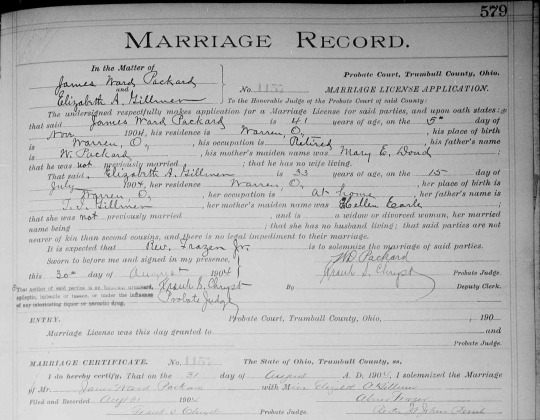
Image is courtesy of "Ohio, County Marriages, 1789-2013," database with images, FamilySearch, James Ward Packard and Elizabeth A. Gillmer, 31 Aug 1904; citing Trumbull, Ohio, United States, reference Marp579; county courthouses, Ohio; FHL microfilm 905,553.
Then we get to James's brother, William Doud Packard. We already know from his gravestone that he was born on November 3, 1861 and died on November 11, 1923. His Find A Grave entry is simple. It states that he is the "brother of James Ward Packard and co-founder of the Packard Motor Car Company," adding that his "grave is not easily seen from the road. When entering the cemetery, drive straight until you get to the hill. It is on the hill up on the right." Sadly, his obituaries in The Pittsburgh Press and Honolulu Star-Bulletin only say he was 63 years old, dying in Warren, Ohio, focus on his business experience, but give no other details about his early life. [1] However, an obituary, in The Times Herald, does note he had a son named Warren Packard, and another, in the Star Tribune, says he had been "blind for the last ten years" (since 1913)! Also, an obituary in The Record-Argus says that William was a nephew of "the late John R. Packard." One article, on February 12, 1940, notes his widow: Kathryn Bruder, who died from a sickness, living in Warren, Ohio.
There are some interesting results for William Packard, including a passport application in 1899, which is reprinted below:
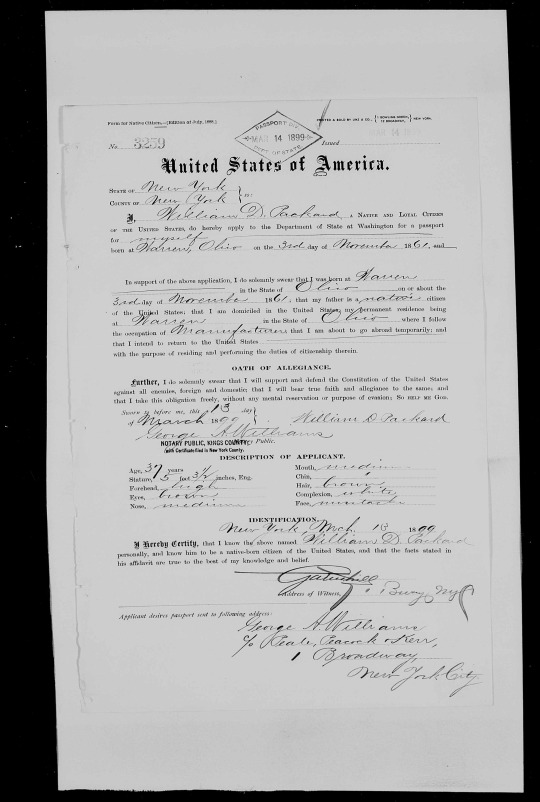
Courtesy of "United States Passport Applications, 1795-1925," database with images, FamilySearch, William D Packard, 1899; citing Passport Application, New York, United States, source certificate #3259, Passport Applications, 1795-1905., 520, NARA microfilm publications M1490 and M1372 (Washington D.C.: National Archives and Records Administration, n.d.).
Apart from the passport application is an even more poignant article, in The Allentown Leader in 1916, later reprinted in other papers (also see here and here), noting his father and the Packard family estate:
The first really pretentious country estate to be built on Chautauqua Lake has been laid out. by Mr, William D. Packard of Warren, O., a member of the Packard Car Company, on a large tract adjoining the Institution grounds on the north. Landscape work has been under way all winter. Mr. Packard is the son of the late Warren D. Packard, one of the pioneer summer residents of Chautauqua Lake and one of those influential in the development of Lakewood several years ago. The property which Mr. Packard has bought lies between the Chautauqua Traction Company's line and the lake and along the north boundary of the Chautauqua Institution enclosure. From this particular point there there is an unexcelled view from Mayville on the north to Long Point on the south, and it is undoubtedly one of the most desirable residence sites of the entire lake region. The house is to be three stories high, of brick, stone and steel construction, red tile roof, absolutely fireproof. It is set in a grove of elms, which surround it on all sides but one, that facing the lake. Directly to the south of the residence gardens are planned, terminating in a wild growth cf shrubbery, threaded with trails leading to the docks and boathouse. to an artificial waterfall, a lily pond, tennis courts and vegetable gardens. A cottage for the gatekeeper and tenants tenants is now under construction, and other buildings will adjoin this cottage. The landscape work has been done under the direction of Mr. H. L. Avery of Cleveland. Eighty-four full grown trees, mostly elms, have been transplanted transplanted by Mr. Herbert L. Hyatt of Cleveland, forester, who has transformed an uninteresting, bare hillside Into a well wooded slope. A great quantity of small planting is also being done. The Packard residence when completed completed will probably represent an expenditure expenditure close to $175,000.
Since William was the brother of James, that means that this article, by extension, confirms that "the late Warren D. Packard, one of the pioneer summer residents of Chautauqua Lake" was James's father as well. This is before the full success of their business, beginning with fights with the Edison Electric Company, to give an example, so such an article is undoubtedly important. The same is the case of a death notice in 1940 noting that Carlotta Packard, age 71 (meaning she was born in 1869), died in Chicago, and was previously a classic New Yorker. Another article, in 1928, talking about William's $1 million estate, said that William's wife was named Katherine (very close to Kathryn) and that he built a home along the same lines as the one in Chautauqua in Warren, Ohio.
In order to further support this post, I'm including the 1870 census, showing James, his brother William, his sisters Alaska and Carlotta, and their parents (William and Mary), living in Warren, Ohio. [2]

Warren is described as a hardware merchant. Mary Oliver and Lydia Shaw are listed as "domestic servants," possibly indicating a level of wealth.
With this, we move onto Warren D. Packard, the father of James and William. His gravestone says he was born on June 1, 1828 and dying on July 28, 1897. One of the photos on Find A Grave seems to say his father was William, as does the entry itself, for which I cannot vouch for:
Born on 1 Jun 1828 to father: William Packard (Born in Washington, Pennsylvania, in 1804 to Packard and Ann Berry. He passed away on Dec. 11, 1877 in Kern, California, USA), and mother: Julia Ann Leach (Born in Mendham Morris, New Jersey, on 2 Nov 1806 to Benjamin Leach and Diana Brown. She passed away on 1891 in Warren, Ohio, USA). He passed away on 28 Jul 1897 in Warren, Trumbull, Ohio, USA.
Newspaper clippings show him as in Warren, Ohio from 1850s onward, including being possibly involved with railroads, along with other tasks, including running a business called Packard & Co. Apart from being related to John R. Packard, his obituary in 1897, in The Akron Beacon Journal listed his children and unnamed wife:
Mr. Warren Packard, father of Mrs. E. B. McCrum of Akron and for nearly half a century prominent in business circles in Warren, died at his home Wednesday. Mr. Packard did much to aid in the advancement of Warren. He was about 70 years old and leaves a wife and five children, J. W. and W. D. Packard, who are well-known businessmen; Mrs. E. B. McCrum of Akron, and Misses Charlotta and Olive, who reside at home.
This aligns with Find A Grave, listing William Doud Packard (1861-1923), James Ward Packard (1863-1928), Alaska Packard Davidson (1868-1934), Carlotta Packard (1869-1940), and Cornelia Olive Packard Gardner (1882-1966) as his (and his wife's) children. There is another obituary in The Buffalo Commercial about Warren as a hotel proprietor, but nothing about his parents. We know that his wife is Mary Elizabeth Doud based on her tombstone, which also says she lived from 1838 to 1903. Her Find A Grave isn't much help here at all. I found an obituary in The Record-Argus, which follows, but without that tombstone, we'd never know what her real name was!
Mrs. Warren Packard died at her home in Warren, O., Friday. While attending a church supper she was stricken with apoplexy and died shortly after having been conveyed to her home. Her husband, Warren Packard, a brother of John R. Packard, died in 1897. Mrs. Packard was one of the society leaders of Warren. The funeral which was held at Christ church, Warren, Sunday afternoon, afternoon, at 1:30 o'clock, was one of the largest funerals held in that city for some time, the church being tested to its capacity. The pulpit, litany, and reading desk, chancel and altar, as well as the pew so long occupied by Mrs. Packard, were covered with floral offerings from the family, business associates of the Packard boys, and friends. The full vested choir officiated in the singing of the hymns, while Rev. H. E. Cooke, the rector, read the service. Friends from Buffalo, Sharon, Greenville, Pittsburg[h] and Youngstown were in attendance. The burial was private at the Paltzgroff cemetery in Lordstown.
We can find even more information from the 1900 census, which lists Mary as the head of household and all her children, still living in Warren, Ohio:
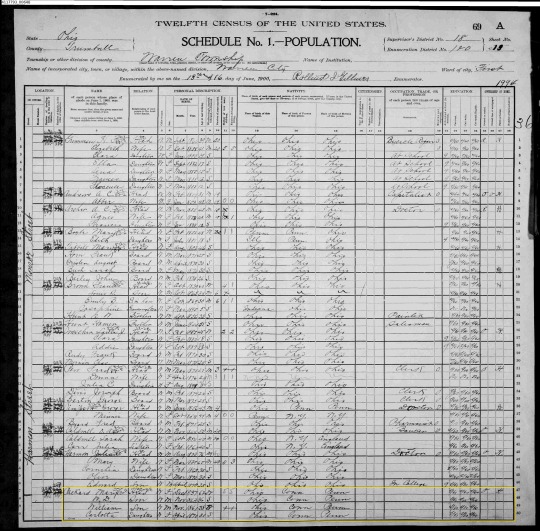
Courtesy of "United States Census, 1900," database with images, FamilySearch, William Packard in household of Mary Packard, Warren Township Warren city Ward 1, Trumbull, Ohio, United States; citing enumeration district (ED) 120, sheet 13A, family 297, NARA microfilm publication T623 (Washington, D.C.: National Archives and Records Administration, 1972.); FHL microfilm 1,241,325.
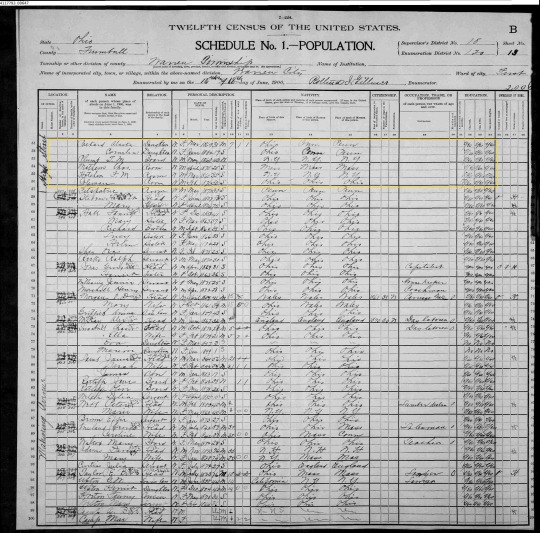
Courtesy of the same resource as the other picture, above.
Note: This was originally posted on June 1, 2018 on the main Packed with Packards WordPress blog (it can also be found on the Wayback Machine here). My research is still ongoing, so some conclusions in this piece may change in the future.
© 2018-2022 Burkely Hermann. All rights reserved.
#packards#packard car company#family history#genealogy#genealogy research#lineage#obituary#cleveland#find a grave#ohio#marriage#national archives#chautauqua lake#census#1870s#servants#1890s#1900s
0 notes
